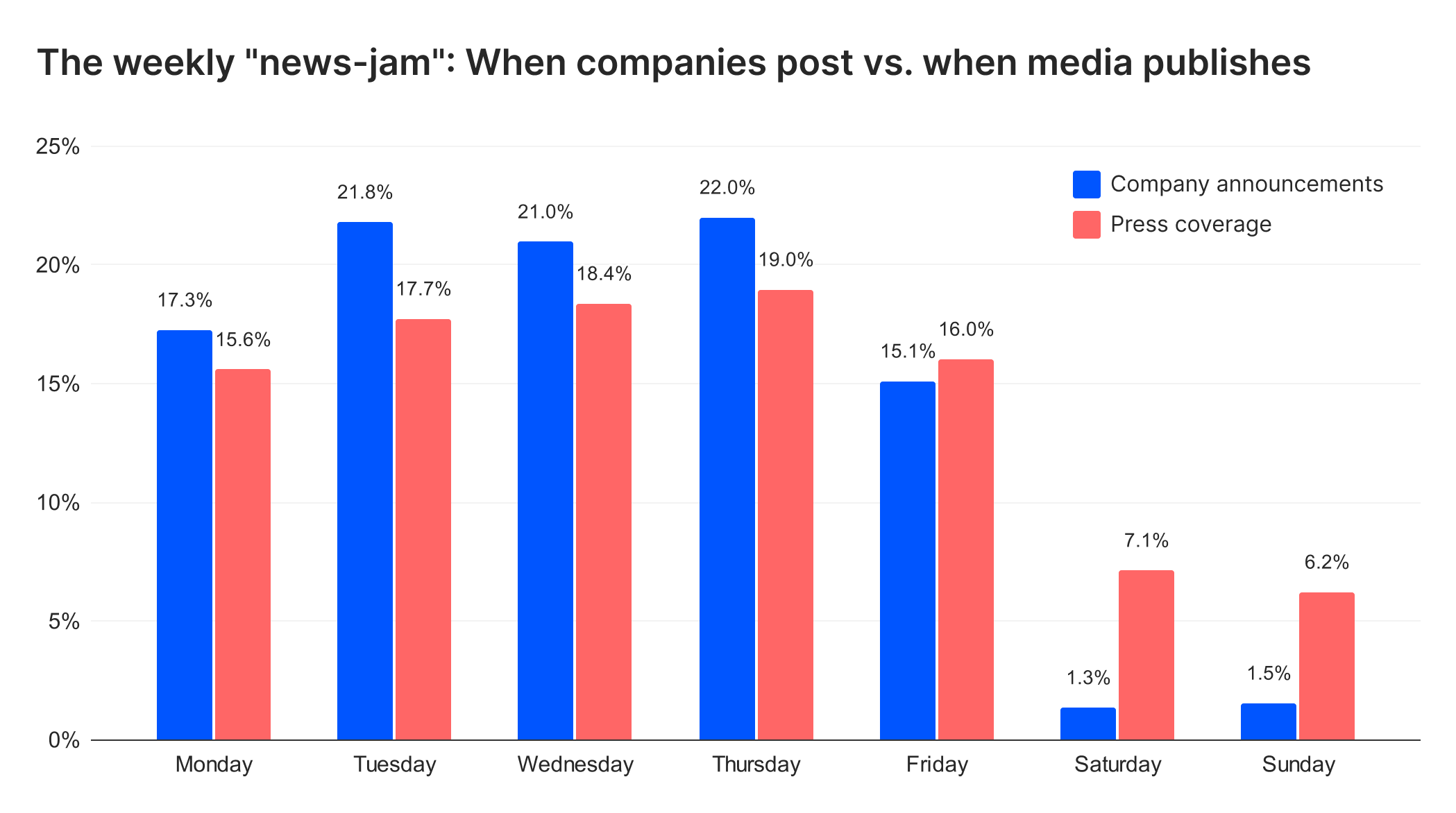We analyzed 1 million articles to find the best (and worst) days to post company news

For any company, timing an announcement feels like a gamble. You have one shot to launch your new product, share your funding news, or publish a big report. Post at the right time, and you get media pickup and customer buzz. Post at the wrong time, and you’re met with silence.
We’ve all heard the conventional wisdom: "Don't post on a Monday, everyone is busy," or "Never post on a Friday, everyone has logged off." But is that true?
At Distill, we track company and media activity, so we decided to find a data-backed answer. We analyzed 200,000 company announcements and 800,000 press articles covering company news – one million data points in total – to find the patterns. The results were not what we expected.
The great mid-week "news-jam"
The first thing we found is that companies are all doing the same thing. They overwhelmingly cluster their announcements in the middle of the week.
A massive 64.8% of all company announcements are posted on Tuesday, Wednesday, and Thursday.
This makes intuitive sense. Teams use Monday to get organized, and they avoid Friday for fear of the weekend. The middle of the week feels like the safest time to post.
But here’s the problem: media attention doesn't peak in the same way. Those same three mid-week days only account for 55.0% of the week's press articles. This means you're dumping 65% of the news into a window that only has 55% of the media's attention. It’s a supply-and-demand nightmare – a "news-jam" where everyone is shouting at once, making it harder for any single story to be heard.

So, when should you post? It depends on your goal.
Our data shows there is no single "best day," but there is a "best day for you." It all depends on your goal.
The Worst Day: Monday
Let's get this one out of the way. Our analysis points to Monday as the worst day to post news. It’s a trap. Companies post 17.3% of their news on Monday, likely trying to "get ahead of the week." But they are competing for the slowest weekday for media coverage, which sits at only 15.6%. You face high competition for the lowest possible reward.
The "Main Event" (Tuesday–Thursday)
This is where the most news is covered, and where the most news is posted. It's the big leagues. These days see the highest total volume of press activity (peaking at 19.0% on Thursday). If you have a massive, industry-changing story and you are confident it can cut through the noise, post it here. You're competing with everyone, but the potential for immediate, widespread attention is at its highest.
The "Strategic Opening" (Friday)
Here is the most surprising insight. Friday is the only weekday where the math is in your favor.
Only 15.1% of companies post on Friday, making it the quietest day for competition. But the press is still very active, publishing 16.0% of its weekly articles.
But what about the "Friday news dump"? It’s a valid concern. You will likely get less immediate social media buzz as people head out for the weekend. However, the data reveals a secret weapon: 13.3% of all press coverage is published on Saturday and Sunday. This is a significant chunk of media attention. Now, compare that to the supply: companies post less than 3% of their weekly announcements on Saturday (1.3%) and Sunday (1.5%). Journalists are still writing, but companies have stopped talking.
Posting on Friday is perfect for "slower-burn" news – thought leadership, detailed product launches, or stories that require more than a glance. You give journalists a story they can dig into over the weekend, free from the mid-week "news-jam."
A simple guide to timing your news
- If you want to be ignored: Post on Monday. It's the worst of both worlds – high competition for the lowest volume of media attention.
- If you have a "blockbuster" story: Post on Tuesday or Thursday. You're entering the "main event" and will have to fight for attention, but the potential audience is at its peak.
- If you want to be noticed: Post on Friday. You trade a little immediate buzz for a much better chance of capturing a journalist's thoughtful attention, especially since they're still writing stories over the weekend.
Understanding these patterns – knowing when your competitors are posting and when you can find your own strategic opening – is what Distill is built for. If you're ready to move from guessing to knowing, check out Distill and start tracking the news that matters.
Distill gives you all the news and insights that matter, when it matters
Start for free